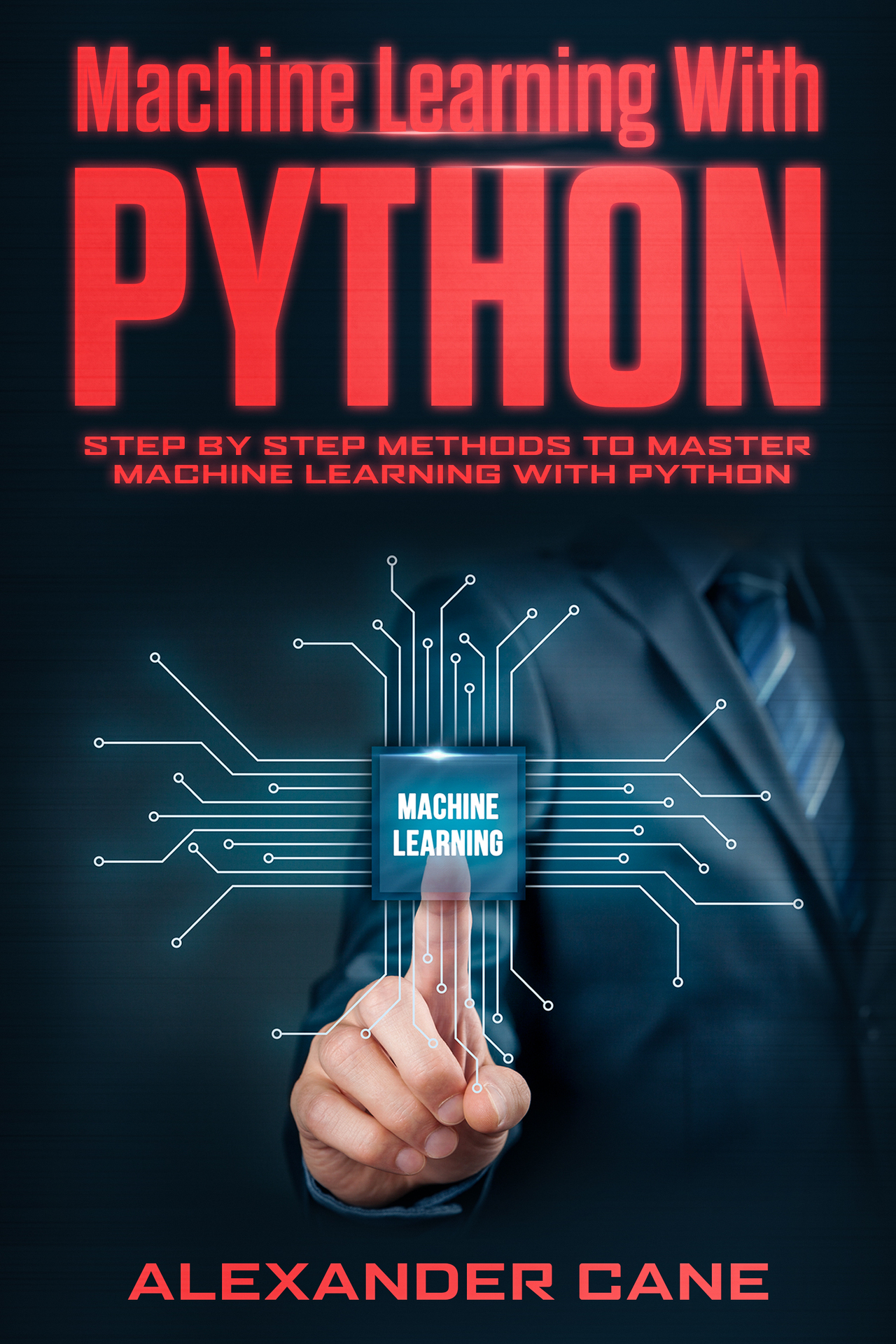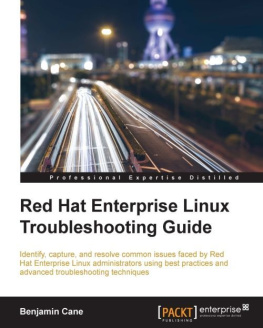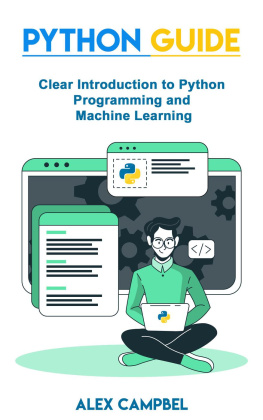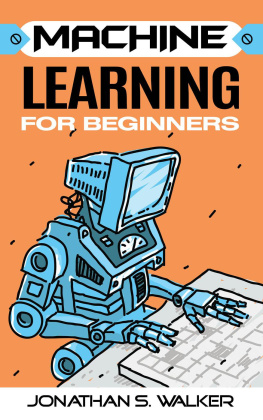Machine Learning with Python
Step By Step Methods To Master Machine Learning With Python
Copyright 2020 by Alexander Cane - All rights reserved.
The contents of this book may not be reproduced, duplicated, or transmitted without direct written permission from the author.
Under no circumstances will any legal responsibility or blame be held against the publisher for any reparation, damages, or monetary loss due to the information herein, either directly or indirectly.
Legal Notice:
You cannot amend, distribute, sell, use, quote, or paraphrase any part of the content within this book without the consent of the author.
Disclaimer Notice:
Please note the information contained within this document is for educational and entertainment purposes only. No warranties of any kind are expressed or implied. Readers acknowledge that the author is not engaging in the rendering of legal, financial, medical, or professional advice. Please consult a licensed professional before attempting any techniques outlined in this book.
By reading this document, the reader agrees that under no circumstances are the author responsible for any losses, direct or indirect, which are incurred as a result of the use of information contained within this document, including, but not limited to, errors, omissions, or inaccuracies.
Contents
Introduction
Thank you for choosing my guide, Machine Learning with Python: Step By Step Methods To Master Machine Learning With Python.
Machine learning is one of the current buzzwords, and its safe to say it is the future. My guide will walk you through the core machine learning concepts using Python. You should already have some knowledge of the Python programming language but I have started the guide with a quick Python primer.
In chapter two, we look at the machine learning basics. This will give you the background you need and a solid base from which to start your machine learning journey. I will teach you the types of machine learning models, particularly the Artificial Neural Network, or ANN. We also talk terminology; it is very important that you understand the terms you will read and hear about.
In chapter three, we move on to machine learning algorithms, and we look at some of the more popular once Ive kept things simple here and you wont need any background in coding to understand this chapter. Well be talking about supervised learning algorithms, unsupervised learning algorithms and reinforcement learning, the three types of algorithm that serve as the backbone for all the other learning algorithms that are being developed right now.
Chapter four deals with pre-processing the data and creating training data sets. This is the part of machine learning that takes the most time and is the most imperative to get right. I will walk you through the stages needed to complete preprocessing and splitting data into training and testing data sets, to make sure you have a thorough understanding.
In chapter five, we move onto Scikit-Learn, one of the most popular machine learning libraries. I will walk you through using Scikit-Learn, using real code that you can try at the end of the day, the only real way to learn is to get on and do it. Well also look at solving common, nonlinear problems with kernel trick algorithms and k-nearest neighbor.
In chapter six, well get to grips with TensorFlow and use it to build neural networks. You will learn everything you need to know, using open-source data and real code. TensorFlow has been built on Python, which is why it is so perfect for the job. It is a simple architecture, flexible, and easily provides for taking a machine learning idea from just that, an idea right through to code, on to building fantastic models and publication, all in a short time.
And, for our final chapter, we look at six tips that you must follow to build a solid data training strategy. Without a strategy, your systems will not work; this is one of the most important steps in any project forget the strategy, you might as well forget building your machine learning model.
We end the guide with a quiz. But, I dont want you to panic here. There are 25 multiple choice questions, but dont worry if you dont know the answer. While some answers will be here, in this guide, the quiz will help you identify areas that you need to practice more, and areas that you can look at in your next stage of machine learning mastery.
Why Use Python?
Its clear that the future is all about artificial intelligence and machine learning. We all want better recommendations, better personalization, and we want much more from our internet searches. The apps we use can see, they can hear, and they can even respond, and that is a direct result of artificial intelligence improving the user experience and bringing much more value across every industry.
This brings two questions to mind, though How do we bring those experiences to life and whats the best computer programming language to use?
The obvious answer is to use Python because it is the best language for machine learning.
Why?
What makes it the best programming language?
Artificial intelligence projects are different from your standard software project, and that difference comes from the technology stack, from the skills that you need for artificial intelligence projects and from the real necessity for deep research.
You need a programming language that offers stability, flexibility, and a wide range of tools. Python gives you all this and more. From development, right through deployment to maintenance, the Python language helps us to be productive developers, confident about what we are building.
The main benefits of using Python for machine learning are:
Simplicity and Consistency
Python gives us code that is readable and concise. While complex algorithms and workflows back machine learning and artificial intelligence, the fact that Python is so simple is what lets us develop reliable systems. As developers, you can put everything you have into solving your machine learning problems rather than having to focus on learning the technicalities of the programming language.
Not only that, Python is one of the easiest programming languages to learn it is human-readable, and that makes it far easier to produce machine learning models.
Lots of programmers are in agreement that Python offers more intuitive programming than any other language while others will tell you that the libraries, frameworks, and extensions are the high point as they simplify the process of implementing lots of different functionalities,
Typically, most developers accept that Python is perfect for collaborative implementation when several developers work on one project, and because it is an all-purpose language, it can do plenty of highly complex tasks in machine learning and let you quickly build your prototypes for testing your machine learning products.
Vast Choice of Frameworks and Libraries
Machine learning and artificial intelligence algorithms are not the easiest to implement, and they take no small amount of time. The environment has to be structured properly and tested to ensure that developers can produce the best solutions.
To help reduce the time needed, Python offers loads of frameworks and libraries. The libraries are code that has already been written, providing developers with an easy solution to common tasks in programming. With one of the richest technology stacks, Python offers a large number of libraries for both machine learning and artificial intelligence. Some of the best are:







